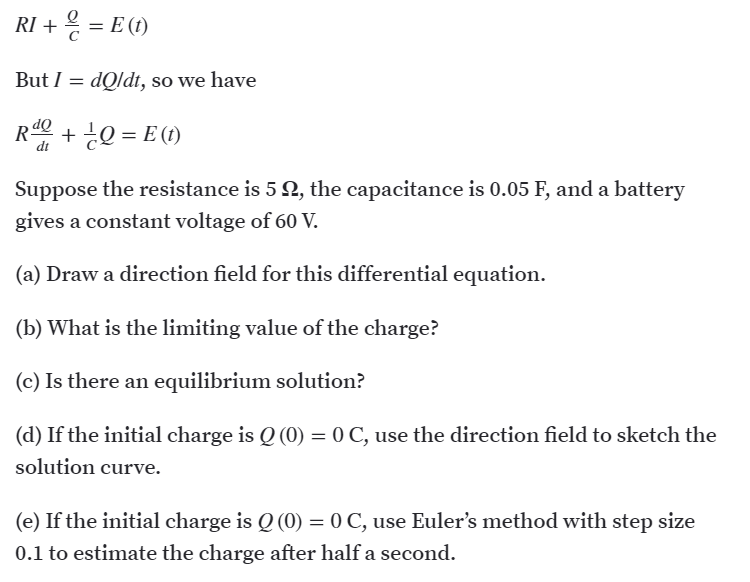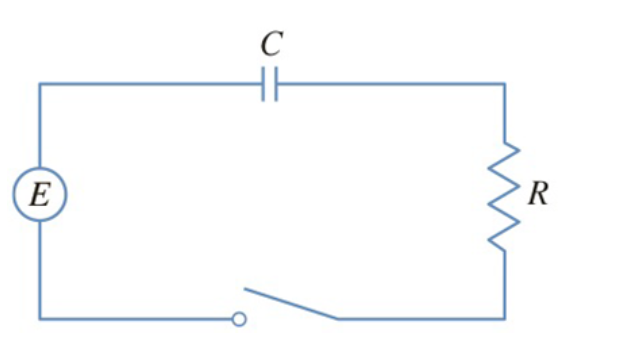RI + = E (1) But I = dQldt, so we have R + ¿Q = E (1) dt Suppose the resistance is 5 2, the capacitance is 0.05 F, and a battery gives a constant voltage of 60 V. (a) Draw a direction field for this differential equation. (b) What is the limiting value of the charge? (c) Is there an equilibrium solution? (d) If the initial charge is Q (0) = 0 C, use the direction field to sketch the solution curve. (e) If the initial charge is Q (0) = 0 C, use Euler's method with step size 0.1 to estimate the charge after half a second. C E R
RI + = E (1) But I = dQldt, so we have R + ¿Q = E (1) dt Suppose the resistance is 5 2, the capacitance is 0.05 F, and a battery gives a constant voltage of 60 V. (a) Draw a direction field for this differential equation. (b) What is the limiting value of the charge? (c) Is there an equilibrium solution? (d) If the initial charge is Q (0) = 0 C, use the direction field to sketch the solution curve. (e) If the initial charge is Q (0) = 0 C, use Euler's method with step size 0.1 to estimate the charge after half a second. C E R
Introductory Circuit Analysis (13th Edition)
13th Edition
ISBN:9780133923605
Author:Robert L. Boylestad
Publisher:Robert L. Boylestad
Chapter1: Introduction
Section: Chapter Questions
Problem 1P: Visit your local library (at school or home) and describe the extent to which it provides literature...
Related questions
Question
The figure shows a circuit containing an electromotive force, a capacitor with a capacitance of C farads (F), and a resistor with a resistance of R ohms (Ω). The voltage drop across the capacitor is Q/C, where Q is the charge (in coulombs, C), so in this case Kirchhoff’s Law gives

Transcribed Image Text:RI + = E (1)
But I = dQldt, so we have
R + ¿Q = E (1)
dt
Suppose the resistance is 5 2, the capacitance is 0.05 F, and a battery
gives a constant voltage of 60 V.
(a) Draw a direction field for this differential equation.
(b) What is the limiting value of the charge?
(c) Is there an equilibrium solution?
(d) If the initial charge is Q (0) = 0 C, use the direction field to sketch the
solution curve.
(e) If the initial charge is Q (0) = 0 C, use Euler's method with step size
0.1 to estimate the charge after half a second.

Transcribed Image Text:C
E
R
Expert Solution
This question has been solved!
Explore an expertly crafted, step-by-step solution for a thorough understanding of key concepts.
This is a popular solution!
Trending now
This is a popular solution!
Step by step
Solved in 6 steps with 8 images

Knowledge Booster
Learn more about
Need a deep-dive on the concept behind this application? Look no further. Learn more about this topic, electrical-engineering and related others by exploring similar questions and additional content below.Recommended textbooks for you

Introductory Circuit Analysis (13th Edition)
Electrical Engineering
ISBN:
9780133923605
Author:
Robert L. Boylestad
Publisher:
PEARSON

Delmar's Standard Textbook Of Electricity
Electrical Engineering
ISBN:
9781337900348
Author:
Stephen L. Herman
Publisher:
Cengage Learning

Programmable Logic Controllers
Electrical Engineering
ISBN:
9780073373843
Author:
Frank D. Petruzella
Publisher:
McGraw-Hill Education

Introductory Circuit Analysis (13th Edition)
Electrical Engineering
ISBN:
9780133923605
Author:
Robert L. Boylestad
Publisher:
PEARSON

Delmar's Standard Textbook Of Electricity
Electrical Engineering
ISBN:
9781337900348
Author:
Stephen L. Herman
Publisher:
Cengage Learning

Programmable Logic Controllers
Electrical Engineering
ISBN:
9780073373843
Author:
Frank D. Petruzella
Publisher:
McGraw-Hill Education

Fundamentals of Electric Circuits
Electrical Engineering
ISBN:
9780078028229
Author:
Charles K Alexander, Matthew Sadiku
Publisher:
McGraw-Hill Education

Electric Circuits. (11th Edition)
Electrical Engineering
ISBN:
9780134746968
Author:
James W. Nilsson, Susan Riedel
Publisher:
PEARSON

Engineering Electromagnetics
Electrical Engineering
ISBN:
9780078028151
Author:
Hayt, William H. (william Hart), Jr, BUCK, John A.
Publisher:
Mcgraw-hill Education,